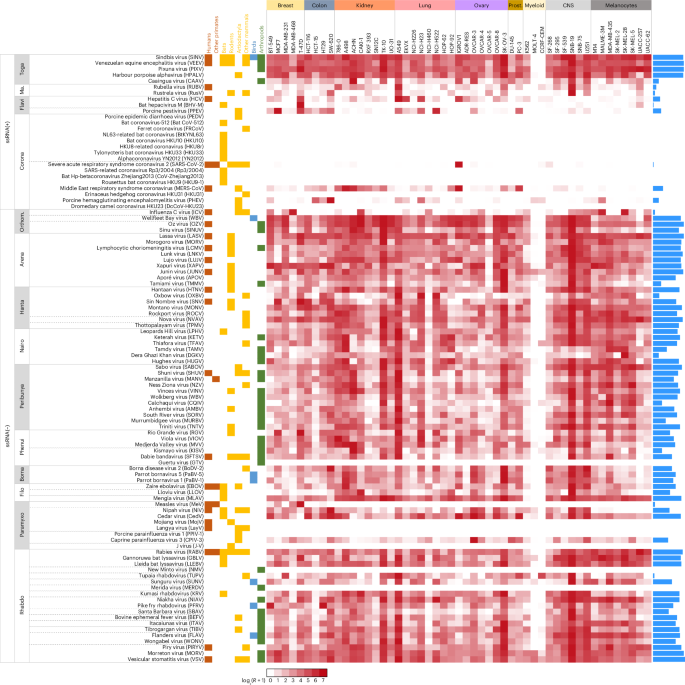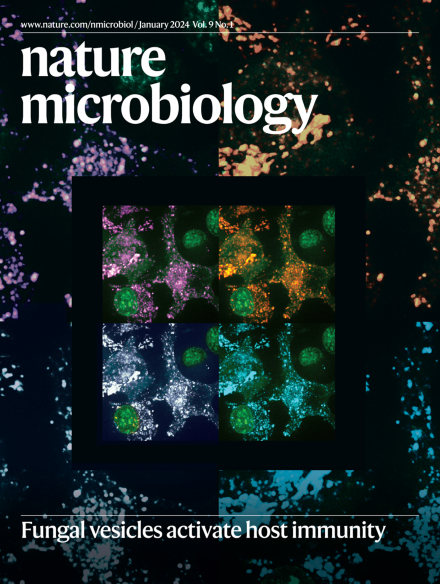来自动物病毒的受体结合蛋白与人类细胞进入因子广泛兼容
IF 19.4
1区 生物学
Q1 MICROBIOLOGY
引用次数: 0
摘要
动物病毒的跨物种传播对人类健康构成威胁。然而,对这些风险进行系统的实验评估仍然很少。病毒感染的关键步骤是由病毒受体结合蛋白介导的细胞内化。在这里,我们构建了携带102种包膜RNA病毒rbp的病毒假型,并检测了它们在5202种rbp细胞组合中的感染性。这表明,大多数被测试的病毒都有可能进入人体细胞。假型传染性在14个病毒科中差异很大,并受RBP特性、源宿主和靶细胞类型的影响。细胞基因表达数据显示,特定细胞表面受体的可用性不一定是限制病毒进入的主要因素,必须考虑其他宿主因素。总之,这些结果表明,在感染的早期阶段,种间屏障较弱,并促进了我们对驱动病毒性人畜共患病的分子相互作用的理解。本文章由计算机程序翻译,如有差异,请以英文原文为准。


Receptor-binding proteins from animal viruses are broadly compatible with human cell entry factors
Cross-species transmission of animal viruses poses a threat to human health. However, systematic experimental assessments of these risks remain scarce. A critical step in viral infection is cellular internalization mediated by viral receptor-binding proteins (RBPs). Here we constructed viral pseudotypes bearing the RBPs of 102 enveloped RNA viruses and assayed their infectivity across 5,202 RBP–cell combinations. This showed that most of the tested viruses have the potential to enter human cells. Pseudotype infectivity varied widely among the 14 viral families examined and was influenced by RBP characteristics, host of origin and target cell type. Cellular gene expression data revealed that the availability of specific cell-surface receptors is not necessarily the main factor limiting viral entry and that additional host factors must be considered. Altogether, these results suggest weak interspecies barriers in the early stages of infection and advance our understanding of the molecular interactions driving viral zoonosis. Functional systematic pseudotype virus-based analysis of the ability of diverse animal viruses to enter into a panel of well-characterized human cell lines shows a broad compatibility between animal virus receptor-binding proteins and human cell entry factors.
求助全文
通过发布文献求助,成功后即可免费获取论文全文。
去求助
来源期刊

Nature Microbiology
Immunology and Microbiology-Microbiology
CiteScore
44.40
自引率
1.10%
发文量
226
期刊介绍:
Nature Microbiology aims to cover a comprehensive range of topics related to microorganisms. This includes:
Evolution: The journal is interested in exploring the evolutionary aspects of microorganisms. This may include research on their genetic diversity, adaptation, and speciation over time.
Physiology and cell biology: Nature Microbiology seeks to understand the functions and characteristics of microorganisms at the cellular and physiological levels. This may involve studying their metabolism, growth patterns, and cellular processes.
Interactions: The journal focuses on the interactions microorganisms have with each other, as well as their interactions with hosts or the environment. This encompasses investigations into microbial communities, symbiotic relationships, and microbial responses to different environments.
Societal significance: Nature Microbiology recognizes the societal impact of microorganisms and welcomes studies that explore their practical applications. This may include research on microbial diseases, biotechnology, or environmental remediation.
In summary, Nature Microbiology is interested in research related to the evolution, physiology and cell biology of microorganisms, their interactions, and their societal relevance.
 求助内容:
求助内容: 应助结果提醒方式:
应助结果提醒方式:


